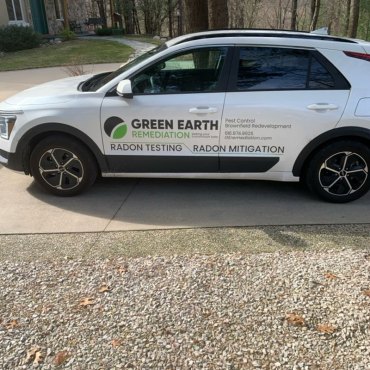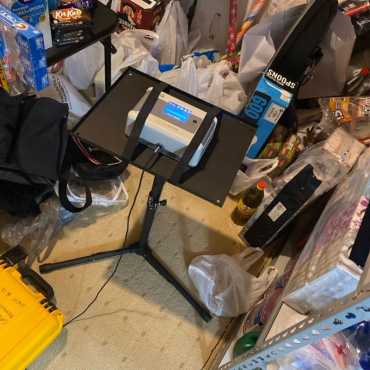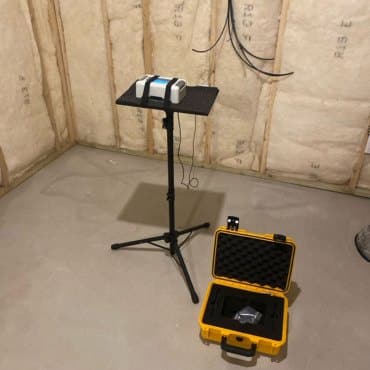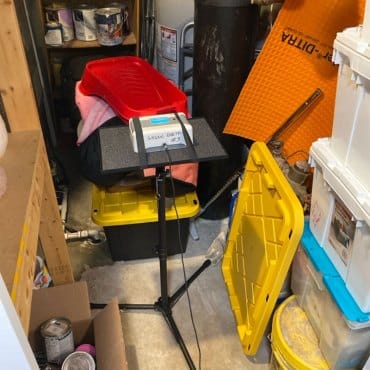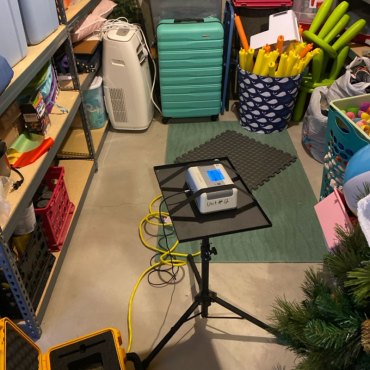
Radon: The Invisible Threat – A Case Study on a Critical Mitigation
Discover how addressing extreme radon levels in a home demonstrated the vital importance of radon testing and mitigation to keep your loved ones safe from hidden dangers.
Protect Your Home and Family with Green Earth Remediation
Radon is a radioactive gas you can’t see, feel, taste, or smell so testing for it is essential. Having your home tested for radon gas is affordable, the process is simple and quick, and the results can be known in a time frame of just over 48 hours. When it comes to residential radon testing there is nothing to lose, considering there is nothing more priceless than the health of you or your loved ones.
Has your home been tested for radon? All outdoor and indoor air contains some level of radon. There is no level of radon that is considered safe, and no feasible way to completely avoid it. In natural environments, like outside your home, levels of radon on average are typically very low (0.4 – 0.7) and not considered harmful.
Radon moves naturally through soil into outdoor air and can easily enter and accumulate inside homes. This natural process can result in a health risk when indoor radon levels become elevated.
Radon gas can only be detected by testing for it, so even high levels of radon gas indoors can remain undetected for years, adding more risk with long term exposure. Anyone can be exposed to this silent killer no matter where they live, regardless of the construction style or age of a home.
At Green Earth Remediation, our mission is to make your environment safer with residential radon testing and custom radon mitigation systems.
Why Choose Us?
Commitment to Excellence
Our mitigation systems are done right. We meticulously create thorough underground suction points to ensure our radon mitigation is not just attached to your property, but effective at reducing radon levels, surpassing the shortcuts taken by others.
Attention to Detail
Our dedication to aesthetics means your radon mitigation system not only works efficiently but also integrates seamlessly with your property's design.
Unmatched Guarantee
We stand by our promise of safety, with the industry's only guarantee of radon levels of 2.0 pCi/L or lower. Complimentary post-installation test is always included to confirm it.
Lifetime Service
With a five-year fan warranty, and a lifelong transferable workmanship guarantee, our commitment to you is as enduring as our solutions.

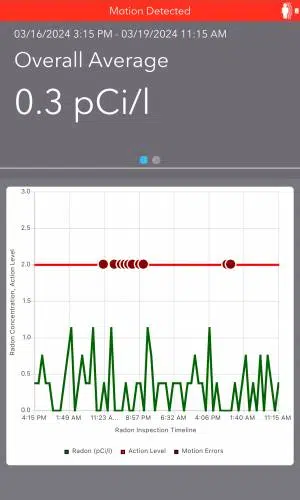
Understanding the Importance of Residential Radon Testing
Radon is such a significant threat because it is a carcinogenic gas estimated to be responsible for 21,000 deaths in the U.S. annually. Radon is the second leading cause of lung cancer among the general public and the first leading cause among nonsmokers. Reducing your exposure to radon gas begins with knowing if it is prevalent in your environment by scheduling residential radon testing.
Why Radon Testing is Essential
Testing your home for radon is crucial because radon levels can vary significantly from one home to another, even within the same neighborhood. The only way to know if your home has high radon levels is through testing. Radon testing is simple and inexpensive, and it provides peace of mind by identifying a potential health risk.
Health Risks of Radon Exposure
Long-term exposure to radon can lead to lung cancer. According to the EPA, radon is the leading cause of lung cancer in non-smokers and the second leading cause overall. The risk of lung cancer increases with higher levels of radon and longer durations of exposure. Radon can enter homes through cracks in floors and walls, construction joints, and gaps around service pipes.
How to Test for Radon
There are two primary methods for testing radon levels in your home: short-term and long-term tests. Short-term tests take between 2 and 90 days, and they are a quick way to get an initial indication of radon levels. Long-term tests take more than 90 days and provide a more accurate representation of the average radon level over time.
Interpreting Radon Test Results
Radon levels are measured in picocuries per liter (pCi/L). The EPA recommends taking action to reduce radon levels if the test results show 4 pCi/L or higher. Even if your radon levels are below this threshold, you may still want to take action to reduce them, especially if the levels are close to 4 pCi/L.
Radon Mitigation Methods
If your home has high radon levels, several mitigation methods can be employed to reduce them:
- Sub-Slab Depressurization: This is the most common and effective method. It involves installing a pipe and fan system to draw radon from beneath the home and vent it outside.
- Sealing Cracks and Openings: Sealing cracks and openings in floors and walls can help reduce radon levels but is usually not enough on its own.
- Improving Ventilation: Increasing the ventilation in your home can help reduce radon levels by diluting the radon gas with fresh air.
Professional Radon Testing and Mitigation Services
Hiring a professional to conduct radon testing and mitigation ensures that the job is done correctly and effectively. Certified radon professionals have the necessary tools and expertise to accurately test radon levels and implement the appropriate mitigation measures.
Additional Resources
For more information on radon testing and mitigation, you can refer to these resources:
Understanding the importance of residential radon testing and taking appropriate action can significantly reduce your risk of radon exposure and ensure a safer living environment for you and your family.
Protection Perfected, Peace Assured, Your Ultimate Peace of Mind Starts Here.
Delivering expert services from trusted professionals to ensure continuous indoor air quality, health, and safety for every home.
MEASURE
Our measurement process is optimized to deliver efficient and thorough results.
MITIGATE
Certified professionals offer system design, installation, and maintenance services for mitigation in any home or building.
MONITOR
Expert products and services ensure continuous monitoring of installed mitigation systems' functionality.
MAINTAIN
Certified professionals provide maintenance services to ensure the longevity and optimal operation of your systems.
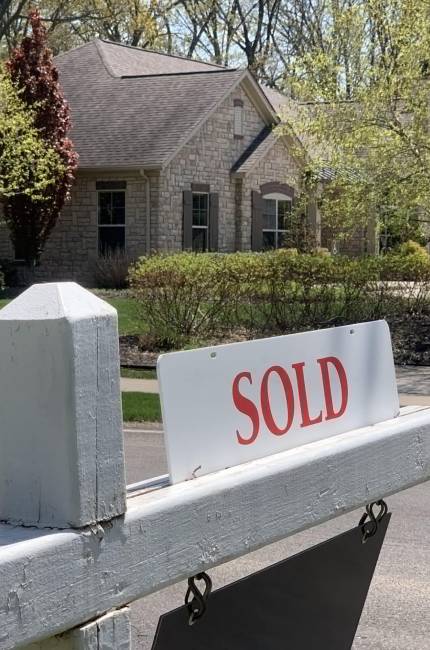
Residential Radon Testing for Real Estate Transactions
Radon Testing for Home Buyers and Sellers
- Rapid, Accurate Testing – Professional testing to deliver results quickly.
- Avoid Delays and Complications – Test and address radon levels to close the sale quickly.
Although radon testing is not a legal requirement for home sales, it is commonly requested by homebuyers as more people are beginning to understand the potential risks of radon exposure. Homes of all ages, sizes, and layouts may have high levels of radon, and the only way to know for sure is with radon testing.
Enlisting professional testing from Green Earth Remediation will provide rapid results and ensure potential homebuyers that the test results are accurate and current. Our technicians are ready to help you address radon quickly without complicating or delaying the sale of your home. If high levels of radon are detected, we can fabricate and install a radon mitigation system before the sale closes with minimal disruption to the property.
Customer Service, It’s What We Do
Green Earth Remediation is proud to be a leading provider of radon testing, radon mitigation, and pest control services for commercial and residential clients. With any service we provide, we aim to offer a top notch customer experience. We’re always willing to go the extra mile to ensure you get the service you need, right when you need it. If you are dealing with a pest infestation or high radon levels, don’t hesitate to reach out to our professional team.
We have decades of experience.
We deliver guaranteed results.
We have a team of experts on hand.
We work quickly to provide effective, long-lasting solutions.

Hear From Our Residential Radon Testing Customers
We are proud to have hundreds of positive reviews on Google from our residential radon testing clients. We invite you to check out some of our recent reviews below or check out our Reviews page for more.

















Find Your Local Service Provider
Green Earth Remediation has numerous locations, and we’re constantly expanding, allowing us to provide the same great service to a growing number of communities. Wondering if we’re in your neighborhood? Check out the map to see areas we’ve served.
Need pest control or radon testing and mitigation services near you? Contact us today!
Residential Radon Testing FAQs
How often should I test my home for radon?
What is a safe radon level?
How can I prevent elevated radon levels in my home?
Installing a radon mitigation system from an NRPP contractor like Green Earth Remediation can reduce radon levels down to levels that are considered safe, we aim to reduce levels to as low as what radon is found in outdoor air.
These systems are called active soil depressurization systems or also referred to as sub-slab suctions systems. The systems help to draw radon gas away by creating a negative pressure underneath the home’s slab and foundation to reduce indoor radon levels. This is achieved by what is called “PFE” pressure field extension, a fan creates a vacuum in the form of a negative pressure under the house that acts as a greater negative force than the natural negative pressure of a home. The movement of air and negative pressure field under a basement slab that a radon system creates is effective as well as efficient at mitigating even the highest of indoor radon levels.
What are the types of radon testing?
There are two basic types of radon testing: short-term and long-term. Long-term testing is any test that is conducted 90 days or more, and this type of testing can give you a more comprehensive view of your home’s radon levels while accounting for seasonal and environmental fluctuations.
We advocate for testing during the colder months of the year, which translates into the heating months. Testing for radon in fall, winter, and even early spring is more important, even though testing for radon at any time is still recommended. The greatest factor for why radon levels are higher at certain times of the year is due to what is called, “stack effect.” When we heat our homes the warmer air rises, this combined with the natural pressure differentials created from the ambient air outdoors being colder than the air indoors makes radon gas able to more easily enter homes and accumulate indoors at higher levels in the winter than in the summer.
My home was tested for radon when I bought it. Do I need another residential radon test?
Residential radon testing should be performed when you move into a new home, but this test will likely be a short-term test that may not show the full picture of radon levels in your home over time. Homeowners should test for radon every 2-5 years, depending on the results of their most recent test and whether a radon mitigation system is already installed.
My neighbors had their home tested for radon, and their home was fine. Do I still need to have my home tested?
Can I test my home for radon myself?
In most states, you can purchase a residential radon testing kit online or at a local hardware store. Some states have these tests available at no charge. These are typically short-term, passive tests that are mailed in for testing in a lab. However, you may get more accurate and rapid results by contacting a residential radon testing and mitigation contractor like Green Earth Remediation.
What is a safe radon level?
When should I test my home for radon?
We recommend residential radon testing during the winter months due to the “stack effect.” When we heat our homes the warmer air rises, this combined with the natural pressure differentials created from the ambient air outdoors being colder than the air indoors makes radon gas able to more easily enter homes and accumulate indoors at higher levels in the winter than in the summer. However, testing at any time is better than not testing at all.
If you’re ready to protect your home and your family with residential radon testing, call Green Earth Remediation today.
Secure Your Radon Safety Consultation
Make Your Environment Safer with Radon Testing and Mitigation
"*" indicates required fields
